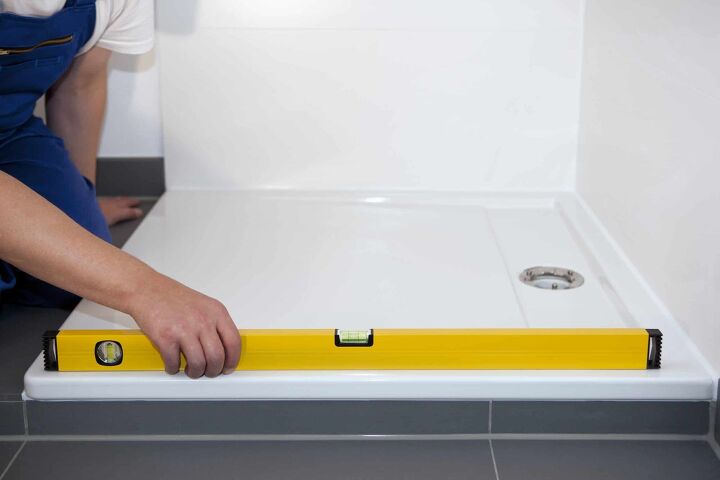Is A Shower Base Better Than Tile? (Here Are the Details)

Bathroom renovations can be some of the most transformational projects to upgrade your home. But they can also cause the most headaches, such as unexpected plumbing issues and tile jobs that go awry. One way to simplify this renovation process is to use a prefabricated shower pan.
A shower base is better if you are renovating on a budget and have a standard-size shower, and there are many different kinds of bases that will suit your variety of needs and specifications. If you have more money to spend, then tiles will give you the most flexibility in both installation and style.
What Is A Shower Base?
A shower base is a single-piece unit that makes up the floor of a standalone shower. It’s also commonly referred to as a shower pan, shower receptacle, or simply the shower floor.
The installation of a shower base is relatively straightforward. Prefab shower bases are made for easy installation on level floors. Just screw in the base to the framing of the stud walls around it. Then, build up your shower walls to your liking.
Types Of Shower Bases
Fiberglass
Fiberglass is the most common material used for shower pans. It consists of one continuous piece of material. Fiberglass panels are low cost (less than $200, not including labor) and rarely leak if installed and maintained correctly.
Unfortunately, they don’t offer too much longevity. Fiberglass shower bases will wear and discolor over time. Mineral deposits from water will collect on the surface, even if you clean the floor frequently.
Cast Iron
Cast iron shower pans are very similar to fiberglass, but much more durable. Just because your shower floor is metal, it doesn’t have to look like it! These pans can be finished and painted in several different colors.
Cast iron is known to hold heat well. While your feet may be chilly on the first step into the shower, they won’t be by the time you’re done.
Acrylic
Similar to fiberglass shower bases, acrylic bases are low cost and easy to install. They can cost as little as $300 for a small unit or as much as $900 for a larger unit with a seat. Different colors are available, with white, grey, and black being the most popular.
For installation, they are fitted to the floor and sealed around the edges with caulk. One of the downsides to this type of pan is that the caulk can fail over time, causing waterproofing issues. Acrylic pans can scratch easily and therefore are not the most durable choice.
Cultured Marble
A cultured marble shower base is a piece of delicate stone cut to fit your shower footprint. The labor cost is higher than other shower pans since this material is more fragile before installation. But once installed, cultured marble is stronger than fiberglass or acrylic bases.
The material cost is higher too, but a worthwhile investment. Marble gives your shower a luxury look and provides longevity unmatched by synthetic materials. The only maintenance needed is a good wipe-down after each shower.
One downside to marble is that it’s a porous stone, so it absorbs quickly. This quality is excellent for it when it gets wet. However, if you spill a soap or shampoo that is colored, then you could have a problem. You might find that your marble picks up a tint if not correctly sealed or treated.
Molded Stone
Molded stone is a combination of natural stone and synthetic plastic. It’s both durable and stylish, giving your shower a high-end feel. It’s resistant to mold and mildew and is easy to clean.
In general, molded stone shower pans start around $800, not including labor. They’re less time consuming to install than tile, saving you money on labor cost.
Ceramic Tile: Pros And Cons
Ceramic tile shower floors feature a mud base, a waterproof liner, and tiles set with mortar. The tiles are then filled in with grout and sealed for longevity. They’re considered more of a high-end finish than a single-piece shower pan because of cost and maintenance.
Pros:
- Design options. There are infinite combinations of size, shape, and color of tiles you can use to finish your shower floor. You can even match the tile to your shower walls, ensuring the tile is rated for both floor and wall use.
- Added value. A well-done tile job adds more value to your home than a prefab shower pan. Exceptions include higher-end stone shower bases, of course.
- Potential for customization. If your shower footprint has odd shapes and angles, you need to build a custom shower base. Laying tile in these spaces is possible, where customizing a prefab shower pan to this shape is not.
Cons:
- Labor and time-intensive. Your average tile job takes longer than setting a shower pan in ideal conditions. The higher labor cost makes tile more costly to install, and the longer timeline can set back other phases of your renovation.
- High maintenance. Grout can crack over time, fall out, and create unsightly and unsafe conditions. Grout lines are also hard to keep clean and are prone to discoloration.
- Tiles can crack. If a tile cracks, it can be difficult to replace. Finding a match for the original material is often difficult. Anyone who has tried replacing a single tile knows that the risk of chipping others around it in the process is frustrating.
Shower Pan: Pros and Cons
Pros:
- Safety. Thousands of injuries occur from slipping or tripping in the shower each year. Especially in multi-generational households, the lower or beveled threshold of a shower pan can mitigate this hazard.
- Ease of installation. Shower pans are designed for a one-day install and are often DIY-friendly. They require less specialized knowledge and tools than tiled shower floors.
- Low maintenance. Unlike tile, you don’t have to clean grout lines or repair individual tiles when they crack.
Cons:
- Drain placement. Drains on prefab shower pans are usually centered in the shower, which is the place most people stand. With tiled shower bases, you can design the floor plan to put the drain where you want it.
- Installation hiccups. Prefab shower bases should be installed in ideal conditions. If you have an unlevel floor or strangely shaped space, installing the base properly will be very challenging.
- Potential for failure. If installed incorrectly, the shower pan may fail. In this case, you need to rip out the whole shower to replace it since you build the walls on top of the base.
Related Questions
Are shower bases more waterproof than tile?
No, not necessarily. While a single-piece shower base may look perfectly sealed to the naked eye, they are not perfect. If the subfloor under the shower is unlevel or the base is improperly installed, the base can crack over time.Tile, similarly, must be properly waterproofed underneath and set well with grout and mortar. With proper installation, both prefabricated shower pans and tiled floors can be 100% watertight.
What walls go best with a prefabricated shower base?
With a prefab shower base, you have the option to add matching prefabricated walls. Like the matching base, these walls work best in a standard-sized space since they’re single units. Some people dislike this look, considering the walls too plain or cheap looking.To give your shower a more distinct look, try out some tile options. You can match your shower pan or do something contrasting. Tile adds more value overall and a more upscale look to any style of bathroom.
Additional Things To Consider
At the end of the day, the decision to use a prefabricated shower pan or tile your shower floor depends on your needs.
Are you seeking durability for years to come, or are you looking for a quick fix? Is your goal to add value to a home for a later sale or flip it sooner for quick cash? Do you prioritize style over affordability or vice versa?
Consider the cost and labor both now and later. The required maintenance and durability over a material’s lifespan may justify a higher-cost decision. No matter what your choice, you can’t go wrong if you install your shower base correctly, and you’re happy with the look.

Stacy Randall is a wife, mother, and freelance writer from NOLA that has always had a love for DIY projects, home organization, and making spaces beautiful. Together with her husband, she has been spending the last several years lovingly renovating her grandparent's former home, making it their own and learning a lot about life along the way.
More by Stacy Randall










![10 Best Cordless Leaf Blowers – [2022 Reviews & Ultimate Guide]](https://cdn-fastly.upgradedhome.com/media/2023/07/31/9070789/10-best-cordless-leaf-blowers-2022-reviews-ultimate-guide.jpg?size=350x220)


![Finishing Basement Without Permit [Is It Really Illegal?]](https://cdn-fastly.upgradedhome.com/media/2023/07/31/9070078/finishing-basement-without-permit-is-it-really-illegal.jpg?size=350x220)




![Cost To Drill A Well [Pricing Per Foot & Cost By State]](https://cdn-fastly.upgradedhome.com/media/2023/07/31/9074980/cost-to-drill-a-well-pricing-per-foot-cost-by-state.jpg?size=350x220)








